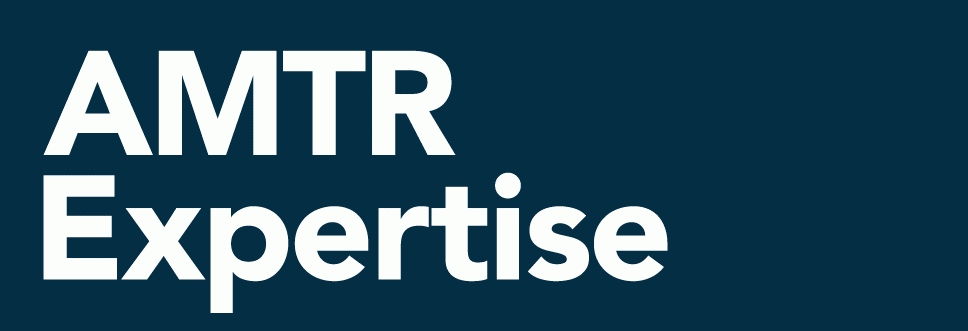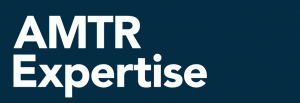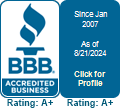On November 19, AMTR lost our beloved leader and CEO, Shan Scott, to neuroendocrine cancer. He fought the illness like he ran the business—with all his heart. He came to work until he could not any longer; this company was his second home, and we were all his extended family.
Shan’s first job out of college was working alongside his father, Ed Scott, and his uncle, Mike Lasiter, the founders of AMTR. Over the years, he performed every job in the company and became an expert truck and rail auditor, as well as a nationally-recognized transportation guru. In 2013, he assumed the position of CEO and springboarded AMTR into a period of innovation and growth that is still ongoing today.
Despite our great loss, AMTR is prepared to “drive on” as Shan would want. For years, there has been a joke at the company related to the phrase “WWSD” (i.e. What Would Shan Do)? Instead of answering questions for us, he worked hard to teach us to think for ourselves, to sort out complex problems, to take care of our clients, and to become the most knowledgeable transportation experts in the business. Upon reflection, he taught us well and prepared us perfectly to move forward.
Shan’s sister, Summer (Scott) Bartczak, PhD, will take over the reins of AMTR as Acting CEO. Besides being a 20+ year Air Force veteran and college professor, Summer has worked closely with Shan and the AMTR leadership in various capacities since 2013, and as such, is no stranger to the business. Although Shan will be sorely missed, the outstanding team he built at AMTR is well-prepared to lead the company into the future as the nation’s premier after-payment freight audit and transportation knowledge services company.
Railway Gazette reported recently that Chief Operations Officer (COO) Cindy Sanborn, Chief Sales and Marketing Officer Fredrik Eliasson, and General Counsel and Corporate Secretary Ellen Fitzsimmons left CSX on November 15th. Former CN executive James Foote will join the company as COO. Nathan Goldman will step up from his current role as VP of Risk Compliance to serve as Chief Legal Counsel and Corporate Secretary.
Railway Age also announced the appointment of Joseph Parsons as the new General Manager of the Iowa Interstate Railroad, as Jerome Lipka retires from the position as President. Al Satunas will assume the position of Chief Operating Officer.
Chicago, Illinois is the busiest rail interchange in North America. Fox Business reports that, in an effort to relieve congestion, Canadian National and Norfolk Southern railroads have brokered a deal to interchange some traffic at Elkhart, Indiana, bypassing the Chicago network. The resultant savings of transit time should be a boon to shippers, providing additional fluidity throughout the rail network. This unusually high level of cooperation in the Chicago area is a particularly timely effort during a time of heavy competition among the eastern railroads.
Raymond P. Martinez was chosen by the Trump administration late last month to become the newest leader of the Federal Motor Carrier Safety Administration (FMCSA). Martinez, former Chief Administrator of the New Jersey Motor Vehicle Commission since 2010, vocalized his support of the Electronic Logging Device (ELD) mandate in the early days of his FMCSA leadership. “The goal is not to cripple commerce. The goal is to make roadways safer,” said Martinez, who acknowledges that the ELD mandate could cause big problems for independent truck owners.
The ELD mandate has technically been in effect for more than 21 months, as the FMCSA rolled out a three-phase compliance plan for those carriers and independent truckers subject to the rule. Phase 1 of this plan started February 16, 2016, and was to be used as a period for carriers and drivers to prepare for compliance. This phase ends December 18, 2017, and marks the beginning of Phase 2. Phase 2 is focused on phased-in compliance and runs through December 16, 2019. Under Phase 2, only Automatic On Board Recording Devices or ELDs that are self-certified and registered with the FMCSA will be accepted. There is some flexibility in Phase 2, however, as safety officials will not enforce the mandate’s out-of-service criteria until April 1, 2018. Phase 3, which mandates full compliance, will require all drivers to utilize self-certified ELDs that are registered with the FMCSA.
AMTR will continue to provide updates about legislation, implementation and any results, positive or negative, from ELDs.
In trucking, the transport of hazardous materials is highly regulated. A shipper is required to notate several things on a bill of lading if a chemical being transported is explosive, flammable, corrosive, combustible, toxic, poisonous or otherwise dangerous. The specific type of hazard must be indicated, as well as the packing group to which it belongs. Packing groups indicate what degree of danger the product presents—I meaning high danger, II meaning medium and III meaning low. Also affecting classification is the handling unit, such as cartons, drums or tanks; therefore, the handling unit type should be listed on the bill of lading. The presence of this information serves to inform drivers what placarding, if any, is necessary when moving the product. It also serves to help carriers determine which NMFC item and class apply.
It is very important that shippers indicate the type of handling unit, the applicable hazard class (from Class 1 Explosives to Class 9 Miscellaneous Dangerous Goods) and the correct packing group that applies to the dangerous goods being shipped to avoid being overcharged. If a shipper indicates a hazard class with no packing group, for instance, the carrier has the right to assume that the highest danger packing group—Packing Group I—applies. The lower the packing group, the higher the charges are, typically. The carrier also has the right to assume that the handling unit type used was the one that results in the highest charges.
Don’t let hazardous goods become hazardous to freight charges. AMTR’s SMART auditors are experts in hazardous goods and NMFC classifications. Let us audit your freight bills today and save you big money!
The rail industry is working hard to implement a number of new technologies that will improve operations and competitiveness. A recent article by Forbes contributor Steve Banker states that rail freight market share has slipped somewhat over faster, more reliable modes of transportation, such as truckload and parcel services. Although moving freight via rail is a relatively low-cost mode of transportation, it is slow by comparison. According to September 2017 statistics of several Class I railroads in North America, the railroads’ speeds averaged about 25 miles per hour. In order to compete, railroads are turning to new technologies in order to provide their customers with better, faster, safer service, and to boost market share.
Initiatives like Positive Train Control (PTC), although legally mandated, will improve safety and increase throughput. Another initiative, Digital Rail Services, launched by tech giant Siemens in Atlanta, Georgia, will create what it calls the “Internet of Trains”. This cloud-based industrial data analytics platform will be able to monitor traffic, identify problems and implement remote diagnostics by collecting and analyzing billions of points of data and turning them into action.
Although such advancements and investments in big tech and big data are good news for the rail industry, they will eventually translate to shipping costs. While increased efficiency in freight movement is welcome, there will still be a need to confirm the billing that follows. AMTR auditors know that change of any kind often generates billing issues—many of which are unexpected and certainly not captured in computer-based audit algorithms. In these cases, there is simply no substitute for human interpretation and intelligence. No matter what the changes, the transportation experts at AMTR stand ready to ensure clients’ freight costs are not adversely impacted.
According to the 2017 Trucking Perspectives report published in a recent issue of Inbound Logistics, the number one challenge faced by shippers is “reducing transport[ation] costs.” Seventy-nine percent (79%) of the Trucking Survey respondents stated that this is their greatest challenge, up from 71% in 2016. Rail shippers are similarly concerned about costs. As reported in the Soy Transportation Coalition’s annual Railroad Report Card released earlier this fall, rail rates were recognized as one of the top two issues.
When talking about reducing transportation costs, there are a number of strategies available to shippers, whether truck or rail. According to Alex Stark of logistics company Kane Is Able, some of the simplest strategies include: contracting steady volume lanes, developing relationships with carriers, increasing efficiency of load/unload times and shipping more product, less often. Of course, there are other front-end strategies to consider; however, implementing a less often thought of—but equally beneficial—freight cost audit on the back end of freight transactions is a strategy worthy of attention, as well. At AMTR, freight cost audits are our specialty. We help our clients reduce transportation costs—some to the tune of millions of dollars—through overcharge claims filing and recovery, freight-related data analytics, and by simply getting to know the ins and outs of their transportation business as if it were our own. Although we use state-of-the art knowledge-discovery technologies to enable our audits, our SMART, human transportation experts are always in the lead. If your company is looking for a NO COST way to reduce your transportation expenses, let’s talk some turkey. With AMTR SMART Auditing®, you will be saying thanks all the way to the bank.
The Trucking Conditions Index (TCI), published monthly by the freight transportation consultancy firm FTR, tracks the changes representing six major conditions in the U.S. truck market: freight volumes, freight rates, fleet capacity, fleet bankruptcies, fuel price and financing. The TCI is focused primarily on contract markets, not spot markets; however, the markets do interrelate.
As reported by Jeff Berman in Logistics Management, the most recent TCI, reported for the month of August, was a modest 1.41; this is a sharp drop from July’s 5.75 and the figure of 6.76 from the previous year. Although the index reading was substantially down, FTR cautions that the August number “is not wholly reflective of the current environment for truckers…[and it] reflects tightening conditions for hauling capacity.” FTR states that a positive TCI reading represents an adequate trucking environment, while readings above ten indicate prices, margin and volumes are in a range that is better for carriers. The August index of 1.41 showed only a “modestly positive” reading for market fleets, possibly signaling big changes ahead and a continued steady increase in spot market rates.
FTR COO Jonathan Starks points out that the increase did not happen all at once. Berman quotes Starks as saying, “… spot markets have actually been moving in this direction for the past year. Load activity was rising, truck availability was falling, and rates were already up over 20 percent year over year before the storms hit. Spot market rates are a leading indicator; and, although there is a lag, contract markets are starting to follow suit. Shippers are now taking notice and are getting worried about dealing with double-digit rate increases as we head towards bid season.”
West Memphis, Arkansas broke ground recently on a major port upgrade that will expand freight rail handling capacity. This $10.9 million intermodal project will connect two major interstates, two Class 1 railroads (BNSF and UP), and the city’s deepwater port. It is expected to be completed in March 2018. This port, which previously supported only 800 railcars per year, is expected to expand to 350 railcars per week upon completion. More info about how this project will affect the rail market can be found at: https://tinyurl.com/http-tinyurl-westmemphisport
Canadian Pacific (CP) is making plans to introduce new environmental surcharges to other Canadian provinces, in addition to those already established for British Columbia and Alberta. CP currently recovers these surcharges through the application of intermodal and carload surcharge rates. The plan is to expand the CP 9800 tariff to include added carbon taxes for each province in which it operates by the end of 2018.










